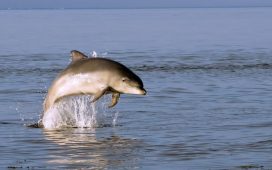The carcasses began to arrive in July.
Residents around the Bristol Bay area of Alaska found thousands of dead short-tailed shearwaters washing up on remote beaches, and sent samples to Anchorage.
“We collected about 100 birds for testing and they didn’t test positive for any diseases or toxins,” says Dr Kathy Kuletz of the US Fish and Wildlife Service.
“They were severely emaciated. The birds had starved.”
Two months later, observers in Australia began to register similar concerns. Every year the shearwaters – also known as mutton birds – make a remarkable 15,000km migration from the northern hemisphere to breeding sites in the Bass Strait and the south-east of the continent.
But this year they have arrived late, and in lower numbers than usual, leading at least one watcher in Victoria to warn that Australia’s most common seabird could suddenly become one of its rarest if numbers plummet drastically this year.
“I’m very, very concerned,” says Peter Barrand, the president of Birdlife Warrnambool.
Patchy and late return
The arrival of shearwaters at places such as Griffiths Island and Phillip Island in Victoria is well known not only for its scale, but also its precision timing.
But this year, something was wrong.
“They arrived about 10 days to two weeks later than usual, and that’s significant,” says Duncan Sutherland, the deputy director of research at Phillip Island nature parks.
In a good year, about 1.4m shearwaters return to burrows on Phillip Island, but Sutherland estimates that numbers are down by half.
The birds that did arrive were in good condition, Sutherland says, but the patchy and late return has him worried.
Many of the shearwaters are now heading towards Antarctica to feed again, before returning to the island to lay just one egg. In April, they fly back to the northern hemisphere.
Back in Alaska, Kuletz believes she may have an explanation for the late arrival of the shearwaters.
“We had some birds staying quite late,” she says. “We had groups that were just too weak to head south. We saw late flocks sitting on the water very late in the season.”
The waters around Bristol Bay are part of one of the world’s biggest salmon fisheries, and Kuletz says gillnet fishers were reporting unusual behaviour from the birds hanging around their boats.

“This is a really remote and widely dispersed area. Most people wouldn’t normally encounter them but [the shearwaters] were coming in, they were weak and approachable.”
Kuletz says about 6,000 shearwaters were reported washed up, but this would have been a “tiny fraction” of those that would have died in remote areas far away from human eyes.
The most likely cause of the deaths, she says, lies in the unusually warm ocean temperatures. The hypothesis is that the warmer waters have dispersed the shearwaters’ main diet of krill, while other fish unsuited to the warmer temperatures have moved away to find cooler waters.
“We’ve had these unusually warm waters and very little ice in winter and spring,” she says.
“The winters have been warming over the last few years. What we are seeing is very much out of the ordinary, certainly since they have been recording temperatures.”
‘Begging for food’
Sean Dooley of BirdLife Australia says the organisation has received reports of dead shearwaters on beaches along the New South Wales coast, as far north as Port Macquarie, to Manly, Bondi, Coogee and Cronulla in Sydney, and as far south as Tathra.
Dooley says it is very hard to know how many shearwaters may have perished, and whether the numbers this year are abnormal. The mass wreck of 2013 is still the worst known, he says, with more than 50,000 birds found dead.
“We are still talking about a bird in its millions,” he says. “Even on good years they arrive with their fat reserves depleted.”
As in 2013, Dooley has heard reports of shearwaters “begging for food” from fishers at Lord Howe Island. “That same thing was happening in 2013,” he says.
It is not unusual to find dead shearwaters on beaches, even in their hundreds, at this time of year. A 15,000km flight will always claim some. But some close observers are worried that something worse is amiss.
For decades Barrand, of Birdlife Warrnambool, has set his calendar to the arrival of the birds to Griffiths Island, near Port Fairy in Victoria. A day or two either side of 22 September, the skies fill with them. This year, they were late.
He says “something like 50%” of the island’s 30,000 to 40,000 have failed to turn up.
“If they return to Alaska to feed with the same catastrophic conditions they’ve had this year, it’s going to decimate the population,” he says.
“If they don’t do well this year, then are we going to go from probably the most common seabird, to something that’s rare, in the space of a couple of generations. I’m very, very concerned.”
On Phillip Island, Sutherland is a little more cautious. “Something strange is happening, but we just don’t yet have evidence to say if it’s at a population level that’s catastrophic, or something else that we are unaware of,” he says.
“They’re our most abundant seabird, but they are clearly vulnerable to changes in the environment given they undertake these massive migrations and they are susceptible at both ends of the planet.
“With more time hopefully we can unravel this. I’m certainly concerned about what’s going on.”
A spokesperson for the NSW government’s environment, energy and science group says monitoring of shearwaters after breeding will not produce results until next year.
“Short-tailed shearwaters appear to be having a poor year, as they did in 2013. The difference being that the westerly winds are not bringing the numbers [of dead birds] onto the beaches this year.
“These seabirds are very resilient to poor food foraging in their non-breeding areas. If conditions are poor, only the strongest breeders will return to breed, and are the more likely birds to raise healthy successful chicks.”








